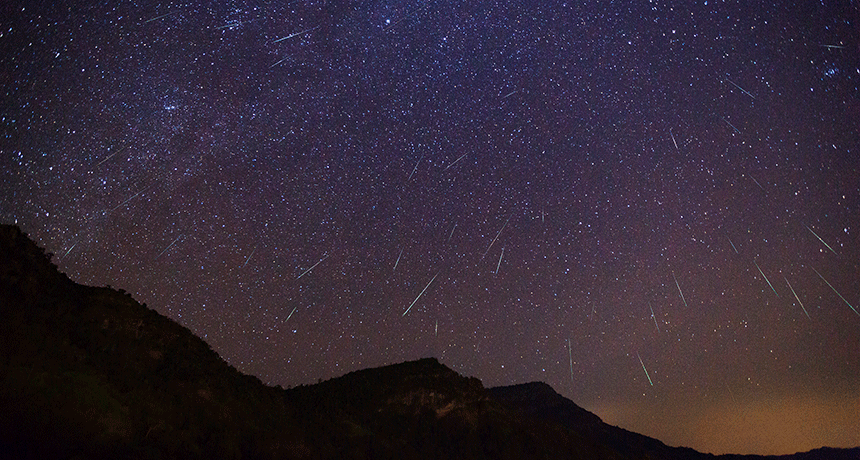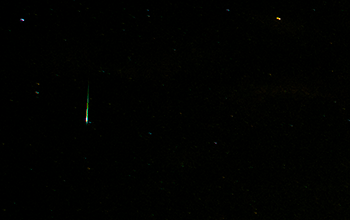Catch a ‘shooting star’ this month — and most others
Rice-sized grains of space rock produce these meteor showers

Commonly called ‘shooting stars,’ these streaks of light in the night sky are meteors caused by bits of space rock crashing into Earth’s atmosphere. The ones shown here are part of the annual Geminid shower.
sripfoto/iStockphoto
They’re called shooting stars. In fact, they’re only bits of space rock burning up in Earth’s atmosphere. This month’s Geminid (JEM-in-id) meteor shower will briefly send streaks of light across the heavens after dark. The night of December 13 (into the 14th) should offer peak viewing. Up to 100 of these shooting stars will spark overhead every hour. But people are still likely to catch a few stragglers the day before and after.
During some years, a bright, nearly full moon will outshine the fainter meteors. This year’s event occurs as the moon enters its first quarter phase. So its face will be only halfway illuminated during the show’s peak. That means plenty of meteors should be visible. Plus, the moon sets before midnight in the lower 48 U.S. states. That means the second half of the night should offer great viewing — if the weather cooperates.
This light show has a humble beginning. Most shooting stars actually are due to rock shards only the size of a rice grain. These interstellar bits are the leftovers of comets, asteroids and larger celestial bodies hurtling through space. Often, these objects leave behind trails of debris in their wake, like pebbles falling off a construction truck.
In the case of this week’s Geminid shower, the space pebbles shooting across the sky come from 3200 Phaethon. This asteroid is a rock 5.8 kilometers (3.6 miles) in diameter. That size was estimated in 2017 during an experiment led by NASA’s Jet Propulsion Laboratory in Pasadena, Calif. That parent rock is the source of all the tiny shards that light the sky on fire each mid-December.
The Geminids get their name because they appear to come from the constellation Gemini. If you traced back the paths of all Geminid meteors from Earth’s perspective, that is the part of the sky from which they appear to emerge. So Gemini is what’s called the radiant of this shower.

The Geminids tend to be the most dramatic and colorful meteor showers of the year. That’s because at roughly 125,000 kilometers (78,000 miles) per hour, they are relatively slow. Their sluggish speed means they last longer in the sky, making them relatively easy to spot. And they leave a brilliant trail that lasts three to four long seconds. In comparison, the Perseid (PER-see-id) showers each August send meteors shooting through the atmosphere at 209,000 kph (130,000 mph).
Their colors are the most amazing part of these light shows. Shooting stars during the Geminids shine a deep, emerald green. Sometimes the edges are tinged violet. A few might even glimmer with a bit of pink, white, yellow or blue. Their colors trace to the minerals in their rocky parent. The Geminids are rich in magnesium, sodium, and iron.
As the rock bits zip through the atmosphere, friction causes them to burn up. In the process, the meteors ionize the air around them, creating azure to turquoise hues. That causes gases in their wake to glow vibrant colors even after the rocks have burned up.
Fireballs are extremely bright meteors that penetrate lower into the earth’s atmosphere. They appear larger and can light up the sky as bright as daytime for a few seconds. Any shooting star brighter than Venus tends to be called a fireball.
The Geminids tie with the Perseid meteor shower for producing the most fireballs.
Other meteor showers
Meteor showers aren’t overly rare. More than a dozen occur each year. How big a display each offers depends on how many space specks they shoot into our atmosphere as meteors. But a show as good as this year’s Geminids only comes once every few years.
Next month will feature the Quadrantids (Kwan-DRAN-tidz). They peak for only a few hours. Still, they have impressive streak rates. For a few hours the night of January 3 to 4, viewers may witness 100 shooting stars per hour.
The Lyrids show up in April. The Eta Aquarid shower produces a few sporadic meteors every May. The Leonids show up every November. And if you’re looking for a good summer memory, then check out the Perseids. Each August 12 to 13, this meteor shower sends more than 100 meteors flying overhead every hour! It’s the best of the year — unless you’re willing to brave a crisp, cold December night for the Geminids.
For best viewing
To catch any meteor show, patience is key.
Pack a blanket, pillow or anything else you need to be comfy as you can. Then bring it to a place with wide open views. The lower to the horizon that you can see, the better. This puts more stellar real estate in view, upping the share of meteors you can glimpse. Ball fields, golf courses and beaches are ideal. Of course, safety is essential — so make sure you are with a group at a safe location.
The spot you choose also needs to be dark. The hours around midnight are the best for viewing. Check local moonset times in your city to figure out when skies will be the darkest. It may also help to monitor the latest weather forecast to know when the best odds of clear skies will be.
Your eyes have to adjust to be sensitive enough to see all the visible stars. Under perfect conditions beneath a moonless sky, you should be able to discern nearly 5,000 stars.
Now lay back and stare upwards. There’s no need to search for the radiant. Shooting stars will eventually streak across the sky.
Above all, it’s important to not give up too soon. Sometimes meteors come in little “packets.” A flurry of three our four may be preceded by several minutes of nothingness.
And put away cell phones. Their concentrated blue light will cause your eyes to adjust back to “daytime mode.” That means no snaps, tweets or other social media that normally captures your attention. Your phone camera won’t be able to capture shooting stars, so don’t even bother trying. Challenge yourself to go an hour technology-free and bask in the wonder of the universe above.
What if it’s cloudy?
Even if it’s cloudy, you still have a chance to marvel over meteors. NASA has a “listening” station at the Marshall Space Flight Center in Huntsville, Ala. It can detect the echoes of radio waves bounced back by meteors. The system is more sensitive than the human eye. At any given time, it can detect between two and 10 more shooting stars than a person would see in a dark sky. You can listen online to the meteor radar’s pings as it captures signals of the meteors.







